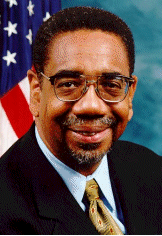Re: Support for increasing the funding of the FCC's Schools and Libraries Program (aka e-rate).
Date: May 26, 1999.
Source: Office of Rep. Rush. This document was created by scanning a fax copy, and converting to HTML.

| Statement by Rep. Bobby Rush (D-IL). Re: Support for increasing the funding of the FCC's Schools and Libraries Program (aka e-rate). Date: May 26, 1999. Source: Office of Rep. Rush. This document was created by scanning a fax copy, and converting to HTML. |
 |
|
CONGRESS OF THE UNITED STATES
HOUSE OF REPRESENTATIVES
WASHINGTON, D.C. 20515
E-RATE NEWS CONFERENCE
U.S. Rep. Bobby L. Rush Statement
May 26, 1999
Good morning.
Right now, thousands of students are arriving at both private and public schools with classrooms that are ill-equipped to handle the demands of teaching in the Information Age. However, hope is on the horizon! Due to special funding, made available through the Education Rate (E-rate) program, thousands of poor schools and libraries will soon be able to bring the Internet and other computer technology to their classrooms. In my district alone, schools and libraries will receive $43.5 million in discounts for Internet wiring and telecommunications services. Nationally, E-rate commitments total $1.7 billion.
Unfortunately, a few of my colleagues, once again, want to change this! They want to jeopardize the future of this crucial program by subjecting some of its funding to the uncertainty of Congress' appropriations process. Cong. Billy Tauzin's bill, "The Schools and Libraries Internet Access Act," poses a number of serious problems to future funding of the E-rate. Not only does it subject the program to annual Appropriations uncertainties. It further threatens the viability of the E-rate by allowing states to be the final decisionmaker as to "who gets what." So, based on history, in many cases, inner city schools will not be the main beneficiaries.
In addition, right now, E-rate funding comes from the telecommunications industry's Universal Service Fund, a monthly service fee that appears on your phone bill. However, under Tauzin, because government funds would be used, parochial and private schools would be left out in the cold. That's because they can not receive government funding.
Out of the universal service fund, only 19 cents, goes to the E-rate. That's a penny and a half a month. Certainly our children's future is worth a penny and half a month!
I'd like to offer a suggestion to my colleagues. "If it ain't broke, don't fix it!" 30-thousand applications for the E-rate discount were received last year and this year, 35-thousand are expected. Clearly, schools and libraries understand this application process and are more than enthusiastic about the program.
Let's not play petty partisan politics with the future of our children and our nation. Our students must be properly prepared to enter and compete in the global job market.
Let's keep the E-rate program in tact and endeavor to fully fund it.